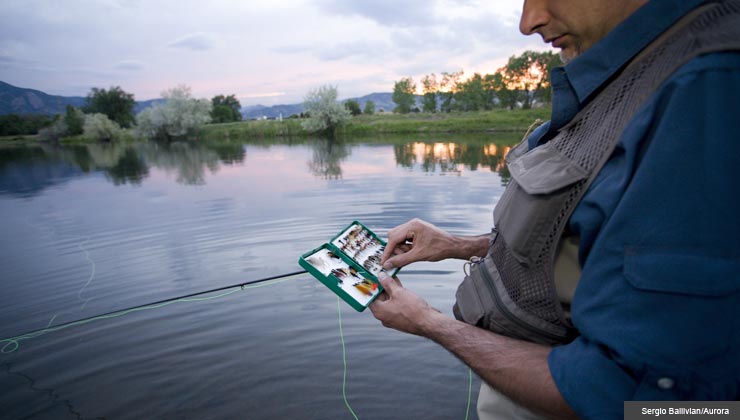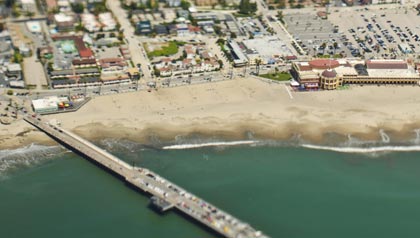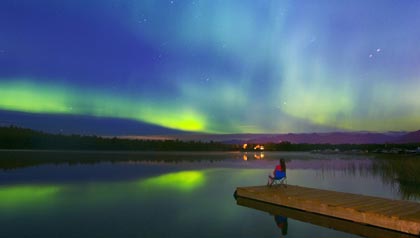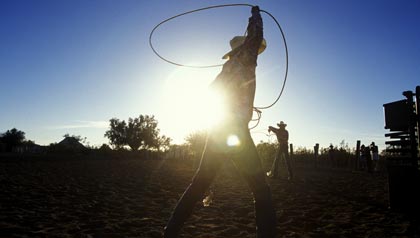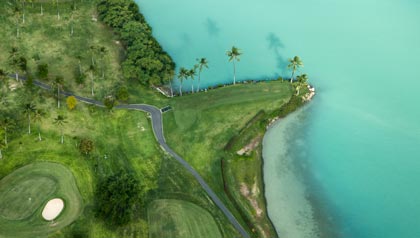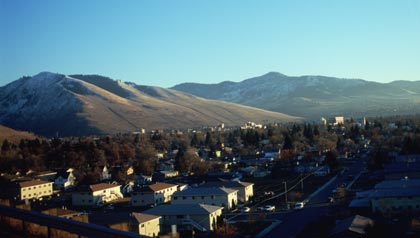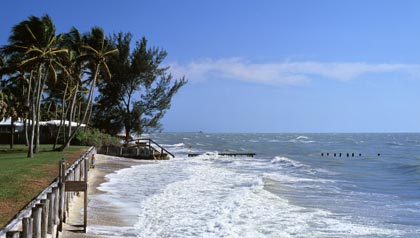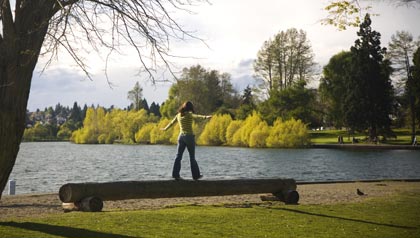Where to Retire If You Love the Outdoors
10 places to swim, hike, ski, fish and soak in the scenery
If you envision retirement as the time when you will finally be able to pursue all those activities that you've squeezed into weekends and vacations — hiking, kayaking, skiing and otherwise immersing yourself in the Great Outdoors — then keep reading.
We've assembled a list of 10 amazing retirement places for people like you. These are cities and towns ideally situated to feed your desire for a greater connection to nature — hiking trails, ski slopes, wilderness areas, roaring rivers, scenic lakes and the awesome ocean — without taking you too far from the civilized world.
Most of our picks are sizable metropolises — Honolulu, Seattle, Minneapolis and Tucson — although others, like Missoula, Mont., have more of a small town feel.
To make our list, cities had to be in or near great nature areas, ranging from Alaska to Florida. We picked places that offer opportunities to view abundant wildlife, and vistas of undeveloped land that inspire. And we still applied our critical review of livability, which means these are cities which have a great mix of affordability, climate, amenities and health resources.
Peruse the list and see if you can find the place that feels just right for you. If you like more than one, you just might have to retire twice!
Boulder, Colorado
The curse Chief Niwot laid on Boulder in 1858 is innovative, if not a tad obvious: "People seeing the beauty of this valley will want to stay, and their staying will be the undoing of the beauty."
See also: America's healthiest hometowns.
It hasn't reached that point but the picturesque college town at the foot of the Rocky Mountains is hard to leave, and that means more Vibram soles, mountain bike treads and dry flies competing for recreational resources.
In the early 1970s Boulder officials approved the first of several local sales tax hikes to buy land for parks. The result is the Greenbelt, a 90,000-acre oasis hemmed by Denver's sprawl. The local parks are heavily used but there is ample room to move — and find your slice of solitude. Even walking the leafy neighborhoods of Victorian homes and bungalows can provide a quick-fix nature lift.
Boulder County (population 294,567) includes Boulder (100,160), Longmont (88,424) and Lafayette (26,146), plus several small hamlets tucked into the mountains. The economy is diverse and strong: Unemployment is only 5.9 percent (September 2011), and the workforce includes a lot of self-employed professionals. The cost of living is very high but Boulder has enough government and high-tech employment to keep incomes almost commensurate.
The University of Colorado at Boulder (enrollment 32,400) and Front Range Community College (15,300) welcome students of all ages. Boulder is the top-ranked metro in the country for the proportion of adults with a four-year college degree but is also a nexus for alternatives in spirituality, education and medicine. You can get a degree in Buddhist Studies from Naropa University here, or study at the Boulder College of Massage Therapy or the Montessori Education Center of the Rockies.
The heart of town is Pearl Street, a four-block pedestrian mall lined with cafes, bars, boutiques and more. For a break from outdoors living, take in a show at the Boulder Theater or tap the university's performing arts slate; in town are several art galleries and a large, well-funded public library system.
Boulder is extremely bicycle friendly, with abundant bike lanes and paths, and mass transit is exceptionally good. The county has several municipal public recreation centers with pools, basketball courts, extensive weight rooms and more. An annual membership is about $300 for senior residents. Locals, unsurprisingly, are extremely fit and healthy overall.
Boulder basks in 300 sunny days per year and the snow that falls tends to evaporate quickly in the semi-arid climate. Summer high temps average in the 80s. If there's a drawback for retirees it might be that relatively few residents are 65 or older, although more move in every year. Thank you, Chief Niwot!
Santa Cruz, California
Santa Cruz happily confirms its stereotype as a surfing-addicted, laid-back town of long- (and gray-) haired hippies. But there is more to this beachside mini-city than peace, patchouli and waves.
See also: Ten best states for retirement.
Residents here enjoy quick-strike access to coastal state parks, redwood and sequoia forests, Monterey Bay — and its eponymous aquarium — and serious mountain-grade hiking. Santa Cruz is also an entrepreneur incubator: The University of California, Santa Cruz's extension division specializes in training people for jobs in nearby Silicon Valley. Also, Cabrillo College (enrollment: 14,000) has a Lifelong Learning Institute for students aged 55 and older.
Santa Cruz County is anchored by the cities of Santa Cruz (population 59,946), Capitola (9,918), and Aptos (9,000) along the northern shore of Monterey Bay. The rugged Santa Cruz Mountains hide smaller towns like Ben Lomond (6,234). To the east is the San Lorenzo River Valley, which was logged in the 19th century but retains its sequoia trees, as well as Big Basin Redwoods State Park. To the south is Watsonville (51,199) and a flat, uber-fertile agricultural region famed for its strawberries and winter vegetables.
The economy in Santa Cruz is slightly better than elsewhere in California. Housing prices are coming down but buyers should tread cautiously until the dust settles further. The local unemployment rate (10.1 percent in September 2011) is above the national average but is falling. Self-employment is big here: There are few high-paying jobs but a lot of entrepreneurial energy.
The city is culturally diverse, with one quarter of its residents Hispanic; 5 percent Asian; and 1 percent black. UCSC sponsors numerous performances, exhibitions, films and lectures, many of which are free. The school's arts division is especially active; Shakespeare Santa Cruz, an internationally renowned theater company, mounts productions in summer and during the holiday season. There's also an annual festival honoring Charles Dickens, and an endowment that supports programs in the arts and culture of India.
Traffic gets bad on winding canyon roads, and a lot of people here have long work commutes, although public transportation and carpooling are popular. Santa Cruz has been honored as a bicycle friendly community, and there are dozens of mountain biking trails, including an eight-mile loop through redwoods at the Forest of Nisene Marks State Park.
Santa Cruz has a high concentration of general practice physicians, but not many specialists and a very low number of hospital beds per capita. But San Jose and its abundant health care resources are only 32 miles away. Santa Cruzians are healthy overall and mortality rates are low, especially from cancer. The metro area has one of the lowest smoking rates of anywhere in the country.
Anchorage, Alaska
Forget outer space: For Americans, Alaska has long embodied the final frontier, a big, untamed world of vast landscapes, towering mountains and lots of bears. That's a fair portrait of the state overall but Anchorage, while surrounded by national and state parks and located near one of the world's richest fisheries, harbors enough urban conveniences and culture to complement the natural bounty and make Alaska's capital city an attractive retirement locale.
See also: The best places to live the simple life.
Kincaid Park, a 1,517-acre forested park in Anchorage, features a public-use chalet along with trails for Nordic skiing, jogging, cycling and hiking, and large fields for all manner of outdoor play. Wildlife includes moose, lynx, bear, fox, eagles and porcupines.
Just north of town, Arctic Valley Ski Area offers year-round outdoor options, from fall berry-picking hikes to winter skiing (although the hill is small, with limited amenities).
You can bring a picnic lunch to Eagle River Nature Center, 40 minutes from downtown Anchorage in Chugach State Park, with trails (hiking, snowshoeing and Nordic skiing) ranging from three to 25 miles, guided walks, a cozy visitor's center and docents to answer questions.
Or take a tour on the Alaska railroad around Turnagain Arm, where the dramatic backdrop of the Chugach Mountains and Cook Inlet make this one of the most scenic routes in the U.S.
On the cultural front, Anchorage boasts a beautiful, four-theater performing arts center that hosts events ranging from the Anchorage Symphony Orchestra and guitar concertos to wine tastings and beauty pageants. The fairly compact downtown offers a decent range of restaurants, from sushi and fine dining to pizza, microbreweries and the expected saloon fare.
A major port for U.S. trade with Asia and the commercial center for a huge, wide-open territory, Anchorage is a good place to find a high-paying job in oil, timber, fishing or trade.
The 1,000-pound gorilla in the room is the weather, but it might be better than you'd think: Yes, the city marinates in a maritime mist and fog for much of the year but the temperatures are not Arctic. The average daily high in January is 20 degrees. In July, it's 66, and the days are 21 hours long.
Much of Anchorage (population 292,000) was heavily damaged in the 1964 Good Friday earthquake — at magnitude 9.2, one of the largest quakes ever recorded — and the rebuilding effort left the city with a stock of modern, clean buildings. The best neighborhoods are located south of town.
Home prices are slightly higher than the national average: a typical house here will cost you about $275,000. But on the upside: There is no sales or income tax, and residents also get an annual royalty payment, ranging from $600 to $1,500, from the state's oil income.
Tucson, Arizona
Looking for that classic desert scene — the vast landscapes, cacti and red rock mesas of the Coyote-Road Runner cartoon feud? Tucson may be calling your name. The city itself has grown significantly in recent decades, but for nature lovers, still offers easy access to a surprising variety of outdoor activity.
Just an hour's drive north of Mexico, Tucson is set in a tight bowl of mountains making it cooler than some other desert areas, such as Phoenix and Las Vegas. This means that Tucson only has one month (June) when the average high temperature is over 100 degrees.
See also: The 10 most affordable cities.
Much of the mountainous area around the city is protected as public land, and the terrain harbors hundreds of miles of hiking and biking trails for all skill levels. Aside from hikes through the Sonoran Desert and forests of massive saguaro cacti, some of which grow to 70 feet tall, options include stream valleys, pine-topped mountains and one of the more impressive publicly accessible cave systems in the U.S. — Kartchner Caverns.
A drive over scenic Gates pass delivers you to the Arizona-Sonora Desert Museum, a sort of zoo-museum combo tied together with excellent walking paths. In winter, you can even ski at the tiny Mt. Lemmon Ski Valley, pasted to the upper flanks of the eponymous 9,000-foot peak just northeast of town.
The center of Tucson still has vestiges of an Old West feel, especially the neighborhood around Hotel Congress, where bank robber John Dillinger holed up in the 1930s. The front desk still uses the original switchboard (from 1919) to call guest rooms and a music club added in 1985 hosts all manner of acts.
The burgeoning 21st century feel comes in large part from the University of Arizona and its 37,000 students. And two-wheeling college students are a big reason why the city of Tucson (542,000) has been honored as a bicycle-friendly community. Even Tucsonians who are well north of college age can take a class at the university's Osher Lifelong Learning Institute.
For culture, the Arizona Theatre Company heads a long list of troupes in town. The Tucson Symphony Orchestra and a major folk festival in May are big draws.
On the downside, property crime rates are high in part due to offenses linked to drugs. Huge amounts of illicit drugs from Mexico and points south pass through Tucson.
Honolulu, Hawaii
Want to retire to a warm, beachy locale without sacrificing city conveniences? The city of Honolulu (population 376,000) may be the place for you.
See also: Best places to retire abroad.
Among Honolulu's 138 miles of coastline, Waikiki is most famous, with masses sunbathing, surfing (novice to intermediate), paddling outrigger canoes, swimming and enjoying life. Southeast of the city is Hanauma Bay Nature Preserve, a recently restored top snorkeling spot. Honolulu is also good for walking: the neighborhoods are divided by ridges, which keeps them feeling small, and local officials follow the Complete Streets school of urban design. Plant lovers can roam the lush Foster Botanical Garden. Beyond town, Oahu offers numerous state parks. Beyond those: seven other Hawaiian islands to explore.
Honolulu's cost of living is the second highest in the U.S., barely lower than San Francisco's. Hawaii is a great place to be a retired government worker: while most pensions from the private sector are taxable, retired government workers and military personnel can withdraw tax-free. A high proportion of residents are aged 65 or older.
This is a literate metro, ranking 22nd of the 69 largest U.S. cities in a study that looked at the concentration of booksellers, education, Internet activity, public libraries, newspapers and local magazines. This is partly due to the University of Hawaii at Manoa (enrollment 20,000), community colleges in Honolulu, Pearl City and Kaneohe, and the private Hawaii Pacific University.
Honolulu is often ranked as a top green city, with stellar scores in air quality, green design, parks, transportation and water quality. Still, despite heavily used mass transit and high rates of carpooling, walking and bicycling to work, traffic congestion is bad because a lot of roads are twisting, two-lane affairs.
Honolulu is loaded with high-quality theater and cultural programs, many sponsored by the University of Hawaii. Catch the oldest American symphony orchestra west of the Rocky Mountains or visit museums that house major collections of Asian, Islamic and contemporary art. A lot of culture also harkens back to the kingdom: concerts of traditional and contemporary Hawaiian music, contemporary art that uses symbols from the old days, and a State Art Museum with artifacts and works by Hawaiian artists.
The concentration of doctors and specialists is very high here, and residents are fairly healthy overall. The metro area's rate of violent crime is below the national average (although the rate of property crime is above average).
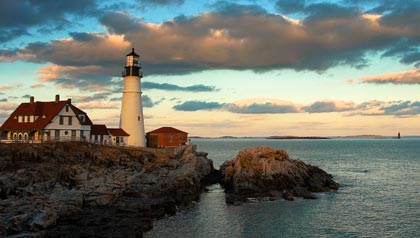
Flickr/Getty Images
Sea air may not cure all but it certainly lowers stress levels, especially in concert with all else Portland, Maine has on offer.
Portland
- Nearest major airport: Portland International Jetport, 4.4 miles
- Mean price for a single-family home: $298,594
- Median household income: $42,010
- Population: 66,194
- Number of residents over age 65: 8,340
- Cost of living: Average
Portland, Maine
Do your retirement visions include seaside walks, harbor-side dining and proximity to top-shelf hiking, boating and skiing, all within a hip, green, amenity-rich city?
See also: America's healthiest hometowns.
Consider Portland, Maine. Here, business professionals step over lobster pots on their walk to work downtown. From Commercial Street you can sit on a bench inhaling salty air and watching birds wheel over islands in Casco Bay. The downtown also includes historic brick neighborhoods, a year-round farmer's market and thriving indie businesses like Longfellow Books.
The large Downtown Arts District is home to the Portland Museum of Art, Portland Stage Company, Portland Symphony Orchestra, Maine Historical Society and Museum, and many smaller art galleries and studios.
In 2009, Portland was named America's Most Livable City by Forbes magazine for its income growth, cultural scene and lack of crime. It has won accolades as an historic destination, a green city, a top spot for outdoor recreation and a haven for creative people.
Portland's cost of living is quite high but so is the median household income, and there isn't much of a problem here with housing foreclosure. As a regional financial center and large port, Portland offers a robust job market. The abundance of outlet malls coaxes more money from the tourists, which puts more sales tax revenue into local government.
Job training is available at the University of Southern Maine (enrollment 11,000), large community colleges in South Portland and Wells, or the ultra-selective Bowdoin College (1,600). The University of Southern Maine has an Osher Lifelong Learning Institute. And the Portland Public Library has a large main building downtown and branches across the metro.
Older retirees will have company here: Portland boasts a high percentage of residents over age 65. Portland is ethnically homogenous; it's almost 95 percent white.
Ocean sailing is big here, as is boating on the many fish-filled lakes and rivers of Maine's interior. But you don't need a boat to see nature's local splendors: Portland Trails, a nonprofit group, manages 31 miles of trails that run throughout the metro. The group hopes to grow that to 50 miles by adding a few trail miles every year.
The average winter high temperatures are in the 40s and 50s, with summer highs in the 70s to around 80. Flooding is a risk on the rivers and creeks flowing into Casco Bay, and the winter can bring nasty Nor'Easters and the occasional paralyzing ice storm.
Minneapolis-St. Paul, Minnesota
Nature, for those in the northern latitudes, is far more than flowers, trees and warm breezes. In Minneapolis-St. Paul, of course, it includes snow. And cold. But nature here also includes lakes, rivers, trails and access to some of the most pristine wilderness in the U.S.
See also: Ten best states for retirement.
Beyond the suburban sprawl, Sherburne National Wildlife Refuge, 50 miles northwest of the Minneapolis, has hiking and Nordic ski trails from which you can watch for dozens of bird species and other wildlife. Numerous lakes within a two-hour drive offer fishing, trails, small beaches and boat ramps. And not much further afield is the vast wilderness of Superior National Forest and the Boundary Waters canoe area.
Minneapolis has more parkland per 1,000 residents than any other large city in the country — 180 parks in all — along with a connected chain of lakes and the Grand Rounds, a 50-mile loop of trails, paths and roadways around the city.
Culture also shines here. The Minnesota Orchestra is regularly mentioned among the best symphonies in the world. The Guthrie Theater's blue building on the riverfront heads up a list of theater companies and art museums so impressive that Minneapolis was recently included in a "where to go next" list by Travel and Leisure, right next to Rome and Montenegro.
Minneapolis-St. Paul may not be flashy — at one point it led the nation in per capital consumption of Cool Whip — but it is smart: A high share of metro residents have a college degree, and the Twin Cities have finished first or second in a ranking of America's Most Literate Cities several times. The University of Minnesota (enrollment 49,000) dominates higher education in the region, but the area has three-dozen degree-granting institutions and an Osher Lifelong Learning Institute.
If you want to eat something other than Cool Whip, St. Paul has a burgeoning restaurant scene, anchored by a handful of excellent ethnic restaurants.
A strong spirit of civic responsibility pervades this metropolitan area. More than four in 10 residents do volunteer work.
The Twin Cities has one of the country's lowest rates of death from heart disease. A large percentage of residents exercise regularly, and similarly high numbers don't smoke. The Agency for Healthcare Research and Quality recently ranked Minnesota first in the United States for the overall quality of its health care.
What keeps most people away is the bone-rattling cold. The average high temperature stays below freezing for about three months of the year. Longevity in the Twin Cities metro area might be due to the fact that its residents are usually refrigerated.
Missoula, Montana
In the recent past, Missoula was a place to get away from everyone else and live a simple life on the doorstep of an amazing bounty of wilderness. Then everyone else heard about it, which fueled Missoula's rapid transformation from a quiet mountain town into a hip tourism and second-home epicenter.
See also: The best places to live the simple life.
A lot of tourists come because Missoula is roughly in the middle of the Golden Triangle of fly-fishing, defined by Glacier and Yellowstone national parks to the north and south, and Idaho's Sawtooth Mountains to the west. Even non-anglers will appreciate the stunning scenery of the surrounding mountains.
Not surprisingly, Missoula's economy, long driven by the University of Montana (enrollment 13,300), is now soundly rooted in tourism.
The city boasts dozens of restaurants, bars, breweries and coffee houses including Italian, Thai, sushi, Mexican and vegetarian-friendly eateries. The downtown shopping district includes an array of boutiques, galleries, clothing, home décor and outdoor gear stores. The local farmers market is a showcase for Montana-grown produce, meat and baked goods.
Much of the culture here is nature inspired: The International Wildlife Film Festival, held annually at the historic Wilma Theatre, is a major event. But there's also a cache of contemporary art at the Missoula Art Museum, which also offers classes and lectures. Missoula's renowned Children's Theatre tours internationally and often needs (adult) volunteers. The International Choral Festival draws choruses from out of state and abroad.
Unemployment is low and the proportion of workers who are self-employed is very high. Missoula is loaded with college-educated young adults. Few residents are age 65 or older.
A lot of people walk or bike to work in Missoula, and the city has been honored as a bicycle friendly community for maintaining over 100 miles of trails, many of which lead into the surrounding mountain wildness. The boundaries of the 2 million-acre Lolo National Forest are just outside of town, one of several huge swaths of public land nearby.
All that healthy outdoor activity helps explain the high life expectancy here — 84.3 years for women and 79.7 for men. Missoula has a high number of doctors for a town its size and the city works hard to educate residents on healthy living. Few residents are obese, few have hypertension and most people say they exercise regularly. Take a look around the wild lands and you'll see why.
Naples, Florida
Naples is the embodiment of the Florida retirement dream: Pleasant winters, beaches galore, most golf holes per resident in the U.S. and tanned, wealthy retirees noshing away in sidewalk cafes and fine restaurants.
See also: Best places to retire abroad.
The beaches are city parks, which means all have showers and restrooms and some have concession stands, boat launches, bait shops, kiddie parks, picnic tables and pavilions. It also means they have rules (for example, no glass bottles or dogs on the beach, permit or metered parking only, etc.) and some residents happily act as self-appointed enforcers.
For more untamed nature, the swampy wilds of Big Cypress National Preserve and Everglades National Park start within an hour's drive.
This metro area of 321,500 people is defined by Collier County, where most people live in subdivisions. These range from gated executive communities to trailer parks. The cities of Naples (population 19,537) and Marco Island (16,413) are the city's historic and touristic centers; inland is the newer City of Golden Gate (23,000) and east of that is Immokalee (20,000), which is cheaper, hotter and buggier.
The recession pummeled Naples. Unemployment stood at 11.4 percent in September 2011. When the housing crash turned into a recession, foreclosures spiked. Home prices are plummeting now but the cost of living remains the highest in Florida. Of course, this is also a chosen spot for the lucky few who commute to high-paying jobs by walking out onto their patios with a cellphone and laptop. The proportion of workers who are self-employed here is very high.
For culture, the Naples Players is a fine community theater, and the local symphony and art museum are based at the Philharmonic Center for the Arts. The center also hosts entertainment of a mainstream sort (recent performers have included Paul Anka, Tom Jones and a traveling production of Legally Blonde) that reflects the area's older, wealthy demographic: Over 42 percent of residents are over age 65.
For sports fans, the Minnesota Twins and Boston Red Sox hold spring training within a 30-minute drive, and have minor league squads playing in the Gulf Coast League.
The air in Naples is some of the cleanest in the country; the city has one of the nation's lowest levels of atmospheric ozone — and one of the highest life expectancies (80.97 years). That may be due to the area's low obesity rate, or the fact that locals are unlikely to smoke and are likely to exercise regularly and eat healthy. People here are also likely to say that they get the emotional support they need, and that they are satisfied with life.
Seattle, Washington
You've seen the photo: person at home, office or cafe, gazing out over open water with snowy peak in distant background. ‘Where is that?' you wondered. Answer: Seattle, blessed by cozy proximity to Puget Sound, two huge lakes (Washington and Sammamish), and the northern Cascade Mountains.
See also: The 10 most affordable cities.
Everything is green in this metro area of 2.5 million people, from the evergreens to neighborhood activists. The area consistently wins accolades for its air and water quality and progressive waste management.
City parks are abundant, many along Seattle's 140 miles of waterfront, with an embarrassment of play space for hikers, joggers, cyclists and kayakers. The massive King County trail system extends for 175 miles and connects to the John Wayne Pioneer Trail, which goes over the Cascades and clear down to the Columbia River. Residents here are willing to spend to preserve their natural environment. In 2008, Seattle voters approved $17.8 billion for a 15-year public transport improvement, and a property tax increase of $145 million for parks and open space. These self-imposed taxes have not hurt the economy. The metro was named "recession-proof" in 2008 by Forbes magazine, and this turned out to be only a slight exaggeration. Although unemployment rose quickly in the first half of 2009, it remains below the national average (8.5 percent in September 2011).
At Pike Place Market you can get fish fresh off the boat and coffee from the first Starbucks store. Or you pop into waterfront restaurants on the piers on Elliot Bay and browse a huge selection of shops downtown, all walking distance to the Space Needle, Seattle Science Center and much more.
The University of Washington's main campus enrolls 39,000 here, and a dozen other universities and colleges offer classes. The Lynwood campus has a Creative Retirement Institute for older students, and the University of Washington has an Osher Lifelong Learning Institute.
The Seattle Symphony performs in a beautiful hall of its own, and equally fine ballet and opera companies perform at the new McCaw Hall. The city has a plethora of working theatrical companies, and lots of interesting venues including the renovated Moore Theatre, built in 1907. Jimi Hendrix grew up here, and the Experience Music Project/Science Fiction Museum and Hall of Fame built in his name features a spectrum of exhibits.
The metro has low death rates from cancer and heart disease and is one of the best places to live if you have asthma or allergies, according to the Asthma and Allergy Foundation of America. Downsides? Winter rain can sock the region in for days on end, and property and violent crime rates are well above the national average.
More on Retirement and Places To Live
- Find your ideal place to retire
- 10 charming cities you shouldn't rule out
- You've Earned a Say about your Social Security
- AARP Retirement Calculator
Join AARP Today — Receive access to exclusive information, benefits and discounts.

